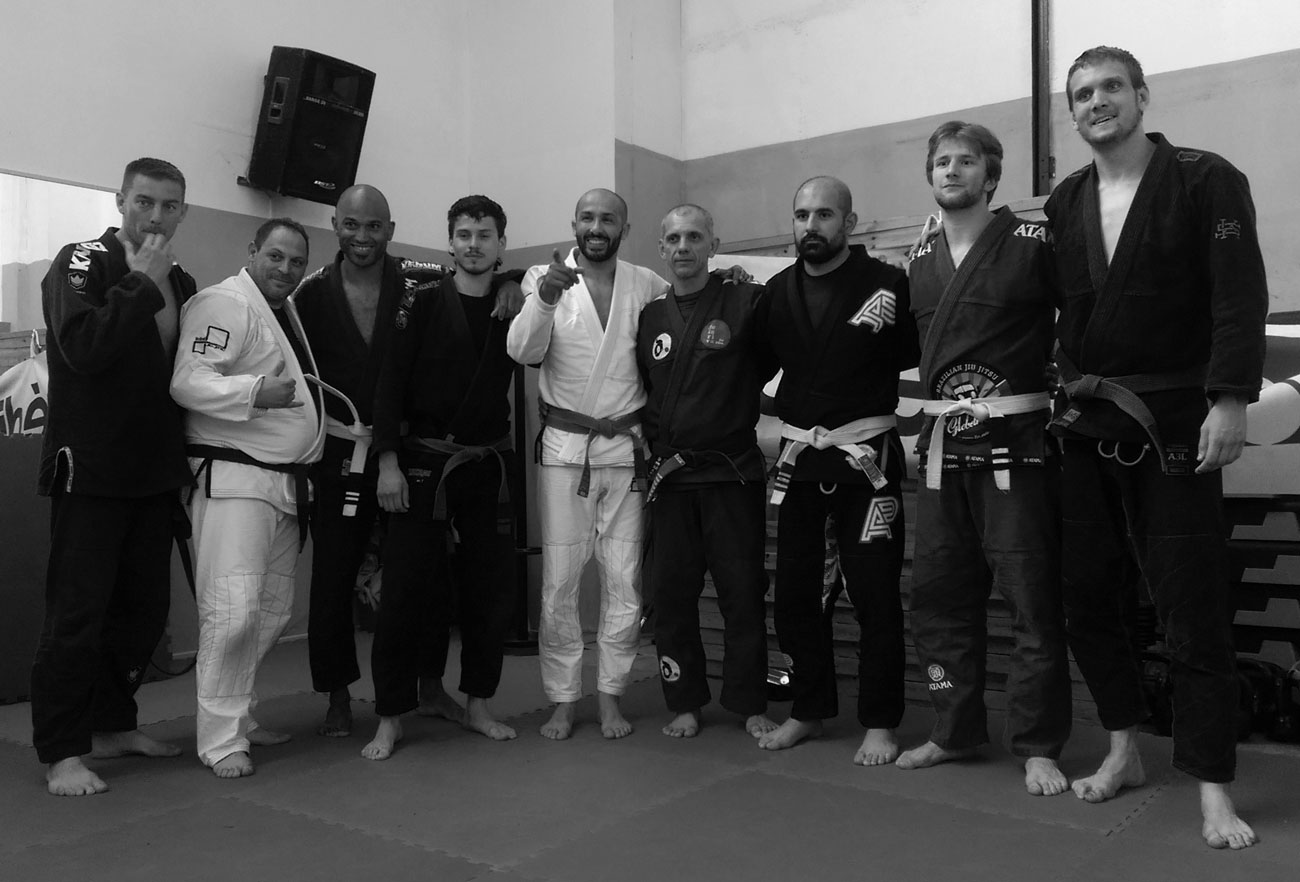The first black belt to ever teach me jiu-jitsu is a student of Ricardo De La Riva and even three years later I’m still finding bits of wisdom in what I was taught that day. To say that I feel close to the DLR school of BJJ would be an understatement as I consider my closed guard and DLR guard corner stones of my game, so you can imagine how much I was looking forward to the seminar with the real Ricardo De La Riva.
Three cars, fourteen people, one hour drive; it felt like summer camp all over again. The seminar was at Dojo Form in Guebwiller where they seem to teach everything, from BJJ to artistic spear fighting and water slide roller blading. Around 70 people lined up on the (relatively small) mats, maybe half of them white belts, and we proceeded to wait for De La Riva to arrive. He eventually did and shook everyones hand, greeting us all in French.

The actual seminar was pretty great; he would show us a technique, explaining it in Portuguese while Salah translated for the rest of us, and then we’d drill it for a few minutes. We covered some closed guard attacks, transition to attacks on an isolated arm and eventually some DLR — my technical notes are below. As I expected, Ricardo De La Riva moves like his students, albeit with the age weighting a little on him.

Althought it was initially scheduled to last two hours, he actually called a stop to the session over three hours in, and even that was only because most of the attendees where practicing less and less. While I think what he demonstrated was very accessible, it can be hard to stay focused over an extended period of time. Fortunately the camp in Copenhagen has made me a lot better at this.

Even after the technique part was done, De La Riva stayed for a lot of photos and was still smiling, not looking annoyed in the least. A very different experience then, say, Joao Miyao. We eventually took of, battled a storm on the highway and made it home about 3 hours later then we all expected. There was definitely some apologetically texting going on on the way back.

In the end, would absolutely recommend. Simple yet clever techniques, very applicable to every day jiu jiu-jitsu from a legend with a cool head.
Technical notes
Opening the guard
We started with the usual DLR guard opening: double sleeve grip, left foot on the hip, knee close to the opponents shoulder. Then the right foot on the mat, knee closed as well, shrimp away.
Triangles
The first triangle is fairly standard: feed the right leg under his arm and go for it. If the opponent pulls the left arm away, switch the triangle to the other side. A nice trick is that if he presses down on my right leg after I passed it on his shoulder, I can try to pull it back in, just so that my knee gets inside his elbow. This creates a strong frame that lasts until the switch to the other triangle is complete.
An idea that he developed in several positions over the seminar is that most defenses involve either pressing down, or pulling away from the guarder. If the opponent pulls away during the triangle and keeps a high posture, DLR closes his guard back again, but this time trapping the arm that is under his high-leg. Say he traps the right arm: he then keeps the sleeve grip on that side and breaks down the posture with his legs and his left hand on the collar. He then re-adjusts his guard and can let go of the right grip because that arm will stay trapped for a while and is hard to pull out. While the opponent is busy trying, he keeps the posture broken down and switches to the triangle again.
If on the other hand the opponent presses down on him, blocking his right leg before it can weave through, he will shrimp his hips out to the left side. He can then weave his left leg in, kick through with his right foot and close the triangle, but on the side that wasn’t expected at first. Sometimes the enemy won’t let you weave the left leg in; if that happens, I have to use my left foot on his bicep to create distance, and then weave it through. To create the initial distance, I can push with my right knee on his chest.
There’s another helpful trick, this time to open up the right sidewhen the oponents clamps his arm tight. You circle the left knee on the outside back into the crest of the elbow, turn to your left side than press. Hard.
This is essentially the concept of the four triangles that David Pierre-Louis taught me a while ago.
Isolated arm
From the same setup, when the opponent presses down, a good go-to position is with my two knees pinched together on his chest; the left one on his shoulder, the right next to his chin. With that position, I have his left arm isolated and can start attacking it. The position is quite similar to the big pressure arm bar that Daniel Bertina taught in Copenhagen.
The first attack he showed was an americana, where you secure the arm with a double grip then turn your upper body towards the outside (not by pushing his arm over there). If the guy postures up, you can follow it up with a straight arm bar; should the pressure be insufficient, you can pull his arm in the gap next to you for maximum effect. Eventually, you can also twist his arm and shoot for an omoplata. In that case, it’s ok to leave my left leg hanging under him until the lock is secured.
Should the guy decide to press you, instead of backing off, you should use your right leg to shoot him over; the motion is similar to an omoplata, but you stop short of rolling him over, instead going for an arm bar from the guard.
Kimura sweeps
From the same position as before, he also showed us a switch to a kimura grip… that was honestly weird. The right-hand grip seems super important but I can’t quite get it right. The idea is to grab his inner elbow with the left hand, and push his wrist inside with the right hand, so that you can secure a kimura grip on his arm. A twist on that grip was that the left hand can either cup over (the usual way) or under, which is a lot tighter but harder to get.
Once in that position, you can, depending on the opponents reaction:
- go to half guard and roll under him if he presses down
- or spin under him, towards the locked arm, if he postures away
De La Riva Guard
Yes, he eventually covered some DLR stuff. One major takeaway that I had missed before is that while he sits out very far off to get the hook in, he then comes back to almost face his opponent and strengthen the hook.
The first set of attacks was based on the DLR hook on one side, and a lasso on the other (double sleeve grips, as always). After taking the lasso though, he planted his foot back on the ground. From there, the first sweep is a simple hip switch, from facing the DLR hook to the other side. This is usually enough to kick over the opponent. From there you can switch to the usual lasso bicep slicer, or get up to side control.
Should the guy sit to the other side during the sweep, you can simply re-switch the hips to complete the sweep on the other side. If that proves troublesome, he also showed a variation where you let go of the lasso and lift the opponents DLR-hooked foot, essentially finishing a single leg.
The final technique was from a DLR-spider hybrid guard, stretching the guy out sideways, making him post on the knee. From there, he ended the sweep with scissor like motions, either sweeping the knee or kicking it away.
Demonstration of most of the techniques by Huseyin, video courtesy of Yohan.
